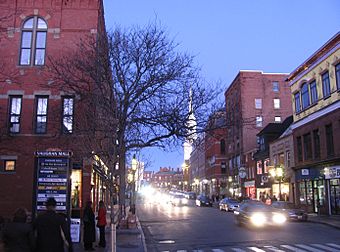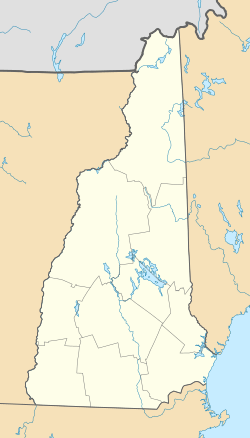Portsmouth Downtown Historic District facts for kids
Quick facts for kids |
|
|
Portsmouth Downtown Historic District
|
|

Congress Street
|
|
| Location | Downtown and adjacent residential areas, Portsmouth, New Hampshire |
|---|---|
| Area | 33.6 acres (13.6 ha) |
| Architectural style | Greek Revival, Late Victorian, Federal |
| NRHP reference No. | 16000820 |
| Added to NRHP | June 19, 2017 |
The Portsmouth Downtown Historic District is a special area in Portsmouth, New Hampshire. It's like a time capsule showing off the city's long history. Portsmouth has been an important place since the 1600s. It was New Hampshire's main seaport and a busy economic hub for a very long time.
This historic district is shaped a bit like the letter "L". It stretches out from the central Market Square. You can find over 1,200 important old buildings here. These buildings show nearly 400 years of history through their different styles. The district was officially added to the National Register of Historic Places in 2017. It even includes 35 places that were already famous on the Register, plus five National Historic Landmarks!
Contents
Discovering Portsmouth's Rich History
Portsmouth is located right at the top of New Hampshire's short coastline. It sits next to the Piscataqua River and near the island community of New Castle. The downtown area, where the historic district is, was first settled way back in 1630. It's bordered by old mill ponds to the north and south.
Portsmouth's Early Beginnings
The town officially became a city in 1653. It quickly grew into New Hampshire's most important port. At first, the city's main business was trading lumber. They especially sent tall ship masts to Great Britain. These masts were used to build big ships for the British navy.
Trade and Growth in Portsmouth
Merchants in Portsmouth also traded with other parts of the Atlantic Ocean. This trade helped the city grow even more. Portsmouth stayed a very important port in the United States until the War of 1812. During this war, some people became very rich from "privateering." This meant they used private ships to attack enemy ships and take their goods.
After the war, trade didn't return to the same busy levels. However, the Portsmouth Naval Shipyard became a major source of jobs. This shipyard is actually on an island in the Piscataqua River, which is part of Kittery, Maine. It was very important for the economy in the 1800s and early 1900s.
Exploring Historic Buildings and Areas
The historic district is full of amazing places. These places tell the story of the city's economy, politics, and daily life. You can see beautiful old homes from the colonial times and the Federal era. These homes belonged to important local leaders and business people.
There are also commercial buildings that are over 200 years old. They show how shops and businesses have changed over time. The district also reminds us how important Portsmouth was as a seaport. The main business area goes from the waterfront west to Maplewood Avenue. Older homes are found stretching west towards Cass Street.
To the south, you'll find Strawbery Banke. This is an outdoor museum where you can see old buildings and learn about life long ago. It shows a part of the city's original waterfront. Nearby is Prescott Park. This park was created to give people access to the beautiful waterfront area. You can also find many old homes between Strawbery Banke and the South Mill Pond. The Portsmouth Cottage Hospital, one of the city's oldest hospital buildings, stands on the banks of this pond.



